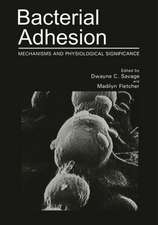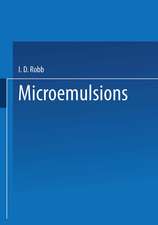General and Applied Aspects of Halophilic Microorganisms: NATO Science Series A:, cartea 201
Editat de Francisco Rodriguez-Valeraen Limba Engleză Paperback – 9 noi 2012
Din seria NATO Science Series A:
- 15%
 Preț: 656.58 lei
Preț: 656.58 lei - 15%
 Preț: 655.13 lei
Preț: 655.13 lei - 15%
 Preț: 678.35 lei
Preț: 678.35 lei -
 Preț: 397.38 lei
Preț: 397.38 lei - 5%
 Preț: 377.87 lei
Preț: 377.87 lei -
 Preț: 397.76 lei
Preț: 397.76 lei - 18%
 Preț: 1232.41 lei
Preț: 1232.41 lei - 5%
 Preț: 731.64 lei
Preț: 731.64 lei -
 Preț: 413.15 lei
Preț: 413.15 lei - 15%
 Preț: 649.22 lei
Preț: 649.22 lei - 5%
 Preț: 369.45 lei
Preț: 369.45 lei -
 Preț: 407.56 lei
Preț: 407.56 lei - 5%
 Preț: 2162.19 lei
Preț: 2162.19 lei -
 Preț: 407.39 lei
Preț: 407.39 lei -
 Preț: 396.40 lei
Preț: 396.40 lei - 15%
 Preț: 663.93 lei
Preț: 663.93 lei -
 Preț: 387.38 lei
Preț: 387.38 lei -
 Preț: 393.13 lei
Preț: 393.13 lei -
 Preț: 398.35 lei
Preț: 398.35 lei -
 Preț: 401.24 lei
Preț: 401.24 lei - 15%
 Preț: 678.81 lei
Preț: 678.81 lei -
 Preț: 395.09 lei
Preț: 395.09 lei - 18%
 Preț: 952.40 lei
Preț: 952.40 lei - 15%
 Preț: 654.43 lei
Preț: 654.43 lei -
 Preț: 402.00 lei
Preț: 402.00 lei -
 Preț: 401.24 lei
Preț: 401.24 lei - 15%
 Preț: 655.27 lei
Preț: 655.27 lei -
 Preț: 394.71 lei
Preț: 394.71 lei -
 Preț: 384.48 lei
Preț: 384.48 lei - 5%
 Preț: 395.61 lei
Preț: 395.61 lei - 5%
 Preț: 1421.57 lei
Preț: 1421.57 lei - 15%
 Preț: 651.34 lei
Preț: 651.34 lei -
 Preț: 400.10 lei
Preț: 400.10 lei -
 Preț: 386.99 lei
Preț: 386.99 lei - 5%
 Preț: 386.11 lei
Preț: 386.11 lei -
 Preț: 403.91 lei
Preț: 403.91 lei - 15%
 Preț: 651.51 lei
Preț: 651.51 lei -
 Preț: 393.90 lei
Preț: 393.90 lei - 5%
 Preț: 376.43 lei
Preț: 376.43 lei -
 Preț: 400.26 lei
Preț: 400.26 lei - 5%
 Preț: 388.84 lei
Preț: 388.84 lei -
 Preț: 400.65 lei
Preț: 400.65 lei - 5%
 Preț: 740.58 lei
Preț: 740.58 lei - 18%
 Preț: 1225.16 lei
Preț: 1225.16 lei - 5%
 Preț: 386.46 lei
Preț: 386.46 lei -
 Preț: 421.82 lei
Preț: 421.82 lei
Preț: 400.85 lei
Nou
Puncte Express: 601
Preț estimativ în valută:
76.71€ • 79.79$ • 63.33£
76.71€ • 79.79$ • 63.33£
Carte tipărită la comandă
Livrare economică 12-26 aprilie
Preluare comenzi: 021 569.72.76
Specificații
ISBN-13: 9781461366607
ISBN-10: 1461366607
Pagini: 416
Ilustrații: XI, 402 p.
Dimensiuni: 178 x 254 x 22 mm
Greutate: 0.72 kg
Ediția:Softcover reprint of the original 1st ed. 1991
Editura: Springer Us
Colecția Springer
Seria NATO Science Series A:
Locul publicării:New York, NY, United States
ISBN-10: 1461366607
Pagini: 416
Ilustrații: XI, 402 p.
Dimensiuni: 178 x 254 x 22 mm
Greutate: 0.72 kg
Ediția:Softcover reprint of the original 1st ed. 1991
Editura: Springer Us
Colecția Springer
Seria NATO Science Series A:
Locul publicării:New York, NY, United States
Public țintă
ResearchCuprins
I Taxonomy, Ecology and Phylogeny.- Halophily, Taxonomy, Phylogeny and Nomenclature.- The Microbiota of Saline Lakes of the Vestfold Hills, Antarctica.- Halophilic Organisms and the Environment.- Estimation of the Contribution of Archaebacteria and Eubacteria to the Bacterial Biomass and Activity in Hypersaline Ecosystems: Novel Approaches.- Some Primary and Secondary Metabolites of Hypersaline Microbial Mats and Associated Sediments.- Taxonomy of New Species of Moderately Halophilic Eubacteria.- Phenotypic Characterization of Halophilic Bacteria from Ground Water Sources in the United States.- II Physiology.- Halophiles of All Kinds: What are they up to now, and Where do they come from?.- Mechanism of Chloride Transport in Halophilic Archaebacteria.- Processes of Adaptation of Different Cell—Lines of Dunaliella to Widely Differing Salt Concentrations.- Osmoregulation in Rhizobium meliloti: Control of Glycine Betaine Biosynthesis and Catabolism.- Is the Na+-Activated NADH-Quinone-Acceptor Oxidoreductase in Marine Bacteria and Moderate Halophiles a Primary Electrogenic Na+ Pump?.- Ionic Relations and Polyol Metabolism of Marine Fungi in Relation to their Environment.- Salt Adaptation of Ectothiorhodospira.- Lipoic Acid and Dihydrolipoamide Dehydrogenase in Halophilic Archaeobacteria.- Nitrate Reduction in the Extremely Halophilic Bacteria.- Retinal-Opsin-Dependent Detection of Short-Wavelength Ultraviolet Radiation (UV-B), and Endogenous Bias on Direction of Flagellar Rotation in Tethered Halobacterium halobium Cells.- Steps in the Photosensory Signal Chair of Halobacterium halobium.- Mode of Action of Halocins H4 and H6: Are they Effective against the Adaptation to High Salt Environments?.- Bioenergetics of Halobacterium halobium and of H. marismortui.- The responseof Halophilic Bacteria to Heavy Metals.- Biochemical Characterization of Dihydrofolate Reductase of Halobacterium volcanii.- III Composition and Structure.- Polar Lipid Structure, Composition and Biosynthesis in Extremely Halophilic Bacteria.- Variations in the Lipid Composition of Aerobic, Halophilic Archaeobacteria.- Bacterioruberins Reinforce reconstituted Halobacterium Lipid Membranes.- The ‘True’ Intracellular Environment of Moderately Halophilic Eubacteria.- Effects of Salinity on Membrane Lipids and Membrane-Derived Oligosaccharides.- Physiology of Halomonas Elongata in Different NaCI Concentratio..- Do Periplasmic Oligosaccharides Provide a Role in the Osmotic Adaptation of Gram-negative Bacteria?.- IV Molecular Biology and Genetics.- The Ribosomal RNA Operons of Halophilic Archaebacteria.- Bacterio-Opsin Gene Expression in Halobacterium halobium.- The Kinetic of the Genetic Exchange Process in Halobacterium volcanii mating.- Physical Mapping and Gene Transfer Methods for Halobacterium (Halo ferax) volcanii.- Gas Vacuole Genes in Halobacteria.- Insertion Elements Affecting Gas Vacuole Gene Expression in Halobacterium halobium.- Genomic Organization Studies in Halobacteria Using Pulse Field Gel Electrophoresis.- Physical and Genetic Mapping of the Unstable Gas Vesicle Plasmid in Halobacterium halobium NRC-1.- Enzymology and Genetics of an Alpha-like DNA Polymerase from Halobacterium halobium.- Phylogeny of DNA-dependent RNA Polymerases: Testimony for the Origin of Eukaryotes.- DNA Topology in Halobacteria.- V Applied Aspects of Halophilic Organisms.- An Application of a Bioreactor with Flocculated Cells of Halophilic Micrococcus varians Subsp. Halophilus which Preferentially Adsorbed Halophilic Nuclease H to 5’-Nucleotide Production.- Novel CompatibleSolutes and their Potential Application as Stabilizers in Enzyme Technology.- Lysis of Halobacteria with Bile Acids and Proteolytic Enzymes of Halophilic Archaeobacteria.- An Archaeobacterial Antigen Used to Study Immunological Humoral Response to C-myc Oncogene Product.- Biopolymer Production by Haloferax mediterranei.- Halophiles in Thai Fish Sauce (Nam Pla).- Liquid Fuel (Oil) from Halophilic Algae: A Renewable Source of Non-Polluting Energy.

















